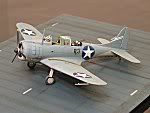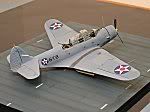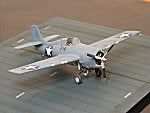Saturday, June 04, 2005
In Memoriam
June 4th marks the 63rd anniversary of the Battle of Midway, the decisive WWII battle which turned the tide of the war in the Pacific against the Japanese. Midway has been the subject of many books and a few motion pictures, so I won't go into the details of the battle other than to retell the basic details. In 1942, flush from victories across the Pacific, the Japanese set their sights on the American base at Midway Island. Seizure of the base would have given the Japanese a vital forward base from which to launch attacks against the American forces stationed in Hawaii. The invasion effort was supported by an impressive naval force of four aircraft carriers, seven battleships, and numerous cruisers, destroyers, and other vessels. To counter this fleet, the Americans offered three aircraft carriers, (one of which had been hastily repaired following damage received at the Battle of the Coral Sea) eight cruisers, an assortment of supporting destroyers and submarines, and a number of Army, Navy, and Marine aircraft based on Midway Island.
In 1942, flush from victories across the Pacific, the Japanese set their sights on the American base at Midway Island. Seizure of the base would have given the Japanese a vital forward base from which to launch attacks against the American forces stationed in Hawaii. The invasion effort was supported by an impressive naval force of four aircraft carriers, seven battleships, and numerous cruisers, destroyers, and other vessels. To counter this fleet, the Americans offered three aircraft carriers, (one of which had been hastily repaired following damage received at the Battle of the Coral Sea) eight cruisers, an assortment of supporting destroyers and submarines, and a number of Army, Navy, and Marine aircraft based on Midway Island. The battle unfolded across four days in early June, with most of the fighting occurring on June 4th. That day saw a remarkable succession of missteps, miscalculations, and strokes of luck, both good and bad, on both sides. The day opened with the Japanese holding almost all the advantages, but the events of that day worked out against them and nightfall saw their hopes shattered as all four of their aircraft carriers had been destroyed. The lion's share of the victory belonged to the pilots of the air groups operating from the American carriers, and particularly to the dive bomber pilots who planted their bombs squarely on the decks of the Japanese ships, and the crews of the torpedo planes who launched their attacks against impossible odds, paying a dear price in the process.
The battle unfolded across four days in early June, with most of the fighting occurring on June 4th. That day saw a remarkable succession of missteps, miscalculations, and strokes of luck, both good and bad, on both sides. The day opened with the Japanese holding almost all the advantages, but the events of that day worked out against them and nightfall saw their hopes shattered as all four of their aircraft carriers had been destroyed. The lion's share of the victory belonged to the pilots of the air groups operating from the American carriers, and particularly to the dive bomber pilots who planted their bombs squarely on the decks of the Japanese ships, and the crews of the torpedo planes who launched their attacks against impossible odds, paying a dear price in the process. The Americans suffered the loss of one aircraft carrier and one destroyer, as well as a large number of land and carrier based aircraft and crews. Considering the magnitude of the victory, it was a fairly light price to pay, and the American manufacturing and training efforts would more than make up for the loss in the years to follow. On the other side, the loss of four aircraft carriers, plus all of their aircraft and most of the aircrews, was a blow from which the Imperial Japanese Navy never fully recovered. And although the war was to rage for three more years, Japan was never able to regain the offense. The eventual American victory required further sacrifices at Guadalcanal, Iwo Jima, Okinawa, and a host of other places, but the seeds of that victory were planted by a small group of brave men who answered the call to duty on that day in June of 1942.
The Americans suffered the loss of one aircraft carrier and one destroyer, as well as a large number of land and carrier based aircraft and crews. Considering the magnitude of the victory, it was a fairly light price to pay, and the American manufacturing and training efforts would more than make up for the loss in the years to follow. On the other side, the loss of four aircraft carriers, plus all of their aircraft and most of the aircrews, was a blow from which the Imperial Japanese Navy never fully recovered. And although the war was to rage for three more years, Japan was never able to regain the offense. The eventual American victory required further sacrifices at Guadalcanal, Iwo Jima, Okinawa, and a host of other places, but the seeds of that victory were planted by a small group of brave men who answered the call to duty on that day in June of 1942.A Tribute
Before I met Yellowbird, my aerial adventures were limited to reading books on aviation history, and building models of whatever airplanes caught my fancy. I was actually very good at it, and I won enough awards at various model competitions to fill several boxes in the basement. One ongoing project, inspired by reading The Big E, Edward Stafford's biography of the USS Enterprise (CV-6), was to build a collection of models representing the aircraft flown by the various air groups that operated from the Enterprise during the war. The following three models from this collection depict aircraft flown by Enterprise Air Group during 1941/1942, and are presented here in honor of the bravery and sacrifice of those who fought at Midway.
 Douglas SBD-3 Dauntless
Douglas SBD-3 DauntlessThe story of Midway is essentially the story of the SBD Dauntless. The SBD was the Navy's principal dive bomber at the beginning of the war, and although it was considered obsolete, it continued in that role until war's end in 1945. This model depicts an SBD-3 of Bombing Six flown by Ensign Frederick Weber on June 4th. Ensign Weber and his gunner, Aviation Ordnanceman Ernest Hilbert, were credited with one of three fatal hits on the Japanese carrier Akagi during the initial attack by American carrier planes. They returned safely to the Enterprise, but were shot down later that afternoon while maneuvering for attack on the carrier Hiryu. The 1/48th scale model was built from the Hasegawa kit with many details added, and represents 6-B-3 as she might have looked prior to her last mission.
 Douglas TBD-1 Devastator
Douglas TBD-1 DevastatorThe sacrifice of the torpedo planes at Midway is an epic story of heroism. Unable to gain an advantageous attack position, and denied protective fighter cover, the torpedo planes pressed on with their low altitude attacks and were decimated by the Japanese fighter escorts. Their sacrifice was not in vain, for by drawing the attention of the Japanese defenses down to wave-top level, they allowed the American dive bombers to launch their high altitude attacks completely unopposed. The timing was purely accidental, but absolutely crucial to the outcome. The 1/48th scale model was built from the Monogram kit and represents a TBD-1 of Torpedo Six as it would have appeared at the time of the Japanese attack on Pearl Harbor in December of 1941.
 Grumman F4F-4 Wildcat
Grumman F4F-4 WildcatDue to the urgency of battle, the American carrier planes faced a number of obstacles in carrying out their attacks. One of these was an unfortunate lack of coordination between the fighter escorts and the torpedo and dive bombers they were supposed to protect. As a result, the fighters made relatively little impact on the American offensive effort. They did provide essential cover for the American naval forces in the face of the Japanese air attacks that crippled the carrier Yorktown. This 1/48th scale model was built from the Tamiya kit and represents an F4F-4 from Fighting Six during May of 1942.
(Historical photographs are hosted by the Naval Historical Center)
